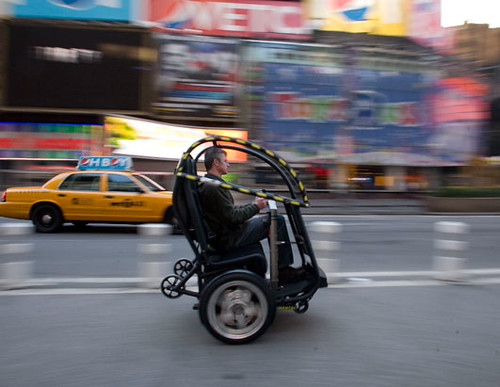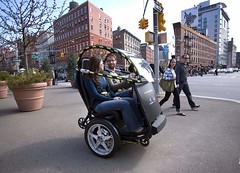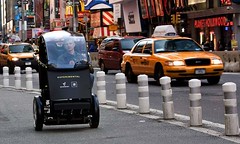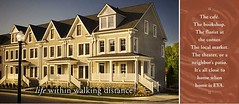The PUMV: Still thinking about private, not public, transportation as a solution for the urban (compact development) environment

Mike Gansler, Director of Core Technology with Segway Inc., drives a Personal Urban Mobility and Accessibility, or PUMA, project prototype vehicle in New York's Times Square. Segway Inc. and General Motors Corp. are working together to develop the two-wheeled, two-seat electric vehicle designed to be a fast, efficient, inexpensive and clean alternative to traditional cars and trucks in an urban environment.(Jin Lee/AP Photo )
PUMV = Private Urban Mobility Vehicle.
Autoweek (and others) reports on a new two-wheeled, two-set electric vehicle in "General Motors reveals two-wheel PUMA electric-vehicle prototype." This is what I wrote in response to a posting about it on the newmobility e-list:
The thing about this prototype (PUMA) is that it appears to be more about personal (privately owned vehicle transporting one or two people) rather than networked (public transit) transportation.
Unlike a car, the PUMA prototype doesn't seem it can carry much in the way of cargo. So what is the point of a PUMA other than enabling people to continue to not ride a bus or subway?
This is demonstrated by the various photos in the Autoweek article.


I use cars from time to time even though I don't own one. Generally it is when we need to carry a lot of cargo. Or we want to go to many places in a short period of time and the transit system for whatever reason doesn't offer a robust set of routes and a schedule which would allow us to do this by transit.
There was a great quote last year in an article in the Boston Globe ("Life with no car is no problem for New Hampshire family") discussing a couple that have switched to bicycle-based transportation. One time when they were thinking of driving, because it was raining, he called the car a "motorized umbrella." Elsewhere I have read of cars referred to as 2,000 pound coffee cup carriers.
By creating "complete places," or what a developer (EYA) in the DC region calls "life within walking distance," the "need" to drive or use transit to accomplish trips can be reduced significantly. Whether or not we can convince people to walk or bicycle instead of drive or use transit is something else. Whether or not we can convince people that it is ok to use transit--engage with other people in a bus, streetcar, light rail car or subway car--rather than drive is another question as well.

I still remember what I thought (as a high school or college student, so at least 25-30 years ago) of a particularly great Dial soap ad on television. It showed a packed bus or subway car, and an attractive woman who didn't want to be there.. Some "nerdy" guy asks her out, and she plaintively wails "I wish I had a car" with the tagline "aren't you glad you use Dial? Don't you wish everybody did." With the packed transit vehicle as emphasis.. I thought it was funny... but now I do see it as a bit more pernicious, reflecting the bias towards "driving by yourself."
So based on the photos of the prototype, I might think of this PUMA just as I think about hydrogen as a fuel, as being about "next generation asphalt nation" rather than transformational (new) mobility.
Labels: car culture and automobility, transportation planning, urban design/placemaking



0 Comments:
Post a Comment
<< Home